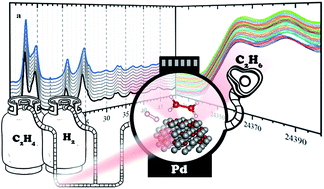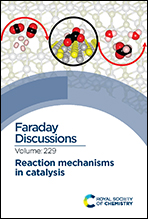Hydrogenation of ethylene over palladium: evolution of the catalyst structure by operando synchrotron-based techniques†
Abstract
Palladium-based catalysts are exploited on an industrial scale for the selective hydrogenation of hydrocarbons. The formation of palladium carbide and hydride phases under reaction conditions changes the catalytic properties of the material, which points to the importance of operando characterization for determining the relation between the relative fractions of the two phases and the catalyst performance. We present a combined time-resolved characterization by X-ray absorption spectroscopy (in both near-edge and extended regions) and X-ray diffraction of a working palladium-based catalyst during the hydrogenation of ethylene in a wide range of partial pressures of ethylene and hydrogen. Synergistic coupling of multiple techniques allowed us to follow the structural evolution of the palladium lattice as well as the transitions between the metallic, hydride and carbide phases of palladium. The nanometric dimensions of the particles resulted in the considerable contribution of both surface and bulk carbides to the X-ray absorption spectra. During the reaction, palladium carbide is formed, which does not lead to a loss of activity. Unusual contraction of the unit cell parameter of the palladium lattice in the spent catalyst was observed upon increasing hydrogen partial pressure.

- This article is part of the themed collection: Reaction mechanisms in catalysis


 Please wait while we load your content...
Please wait while we load your content...